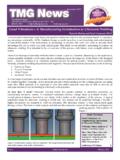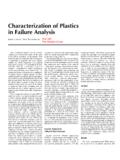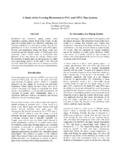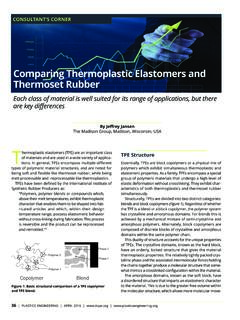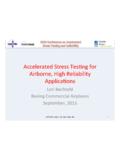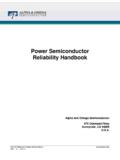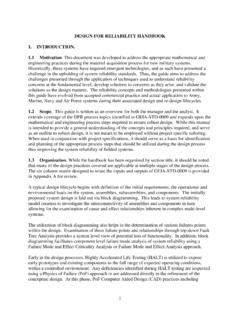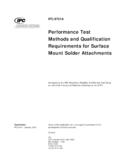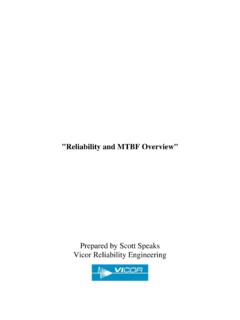Transcription of Plastic Failure through Environmental Stress Cracking
1 CONSULTANT S CORNERP lastic Failure through EnvironmentalStress CrackingESC, the Plastic killer, is a frequent cause of field failuresBy Jeffrey JansenThe Madison Group, Madison, Wisconsin, USA Environmental Stress Cracking (ESC) is considered a lead-ing cause of Plastic part Failure . It is the prematureembrittlement and subsequent Cracking of a plasticdue to the simultaneous and synergistic action of Stress andcontact with a chemical agent. Because of the frequencyand severity of ESC Failure , it has been nicknamed the plastickiller (see, for example, Figure 1).
2 A principal consideration in the relatively high Failure rateassociated with Environmental Stress Cracking is the wide-spread lack of awareness and understanding of theinteraction between Plastic materials and chemicals, partic-ularly organic-based chemicals, which are so prevalent inmanufacturing, commercial, and household settings. Mostfailures associated with ESC occur through contact with asecondary chemical agent. A secondary chemical agent isone that is not anticipated to contact the molded Plastic partthroughout its is in contrast to a primary chemical agent, where con-tact is expected, such as gasoline with a small-engine fuelfilter, or paint with the tubing in a paint sprayer.
3 Failuresconnected with primary chemical agents are rare in servicebecause the chemical compatibility is well understood atthe design phase. Failures associated with secondary chem-ical agents are far more common. ESC MechanismA common misconception about Environmental Stress crack-ing is that it involves molecular degradation or chemicalattack of the Plastic material. This is not true. The ESC failuremechanism does not proceed through a chemical reactionbetween the polymer and the chemical agent. Molecularstructure alteration or degradation does not occur.
4 Signifi-cantly, in the absence of the chemical the Plastic would30| PLASTICS ENGINEERING | NOVEMBER / DECEMBER 2015 | | 1: Catastrophic Failure occurred in a CPVC pipethrough ESC associated with contact with an incompatiblesound-proofing Stress Cracking in air, also known as creep rupture,given sufficient time. The chemical simply accelerates thestress Cracking . Because of this, Environmental Stress crackingand creep rupture are parallel Failure reviewed in the July/August 2015 issue of Plastics Engineering(p. 32), creep is the tendency of a solid materialto deform permanently under the influence of constantstress, and occurs as a function of time through extendedexposure to levels of Stress that are below the yield pointof the material.
5 Creep rupture is Cracking within a plasticcomponent that occurs as a response to Stress that occursthrough disentanglement of the polymer chains by over-coming intermolecular forces, such as Van der Waal s forcesand hydrogen bonding, between the polymer factors will accelerate the embrittlement processassociated with creep rupture, including an increase in tem-perature, Stress concentration within the part, cyclic loading,fatigue, and contact with specific chemical agents (ESC). Inenvironmental Stress Cracking , the chemical agent permeatesinto the molecular structure of the Plastic , interfering withthe intermolecular forces bonding the polymer chains, allowingaccelerated molecular disentanglement.
6 This reduces theenergy required for disentanglement to occur. The presenceof a moderate Environmental Stress crack agent can result inan order of magnitude reduction in the time to important consideration is that the chemical agent doesnot permeate substantially into the Plastic material, and onlythe material on the contact surface is affected. The bulk prop-erties of the material, including stiffness and strength, arenot affected. Other chemically induced Failure mechanisms,such as plasticization and solvation, include further interactionbetween the chemical agent and the Plastic .
7 Cracks associated with ESC Failure generally initiate atlocalized areas of Stress concentration, such as a design cor-ner or notch in the part, a defect, a surface scratch, or acrack. The Stress concentration factor associated with theseconditions can range from to 5 and higher. Under con-ditions of chemical contact, the chemical agent permeatesinto the molecular structure of the polymer chains prefer-entially at the elevated Stress field associated with theconcentration factors. Very localized plasticization takesplace via Stress -enhanced fluid response to the Stress and facilitated by the plasticizingeffect of the chemical, the individual segments of the chainsrotate, and become aligned parallel to the direction of themaximum strain.
8 Crazes are formed as planar arrays of finevoids normal to the tensile Stress (Figure 2a). The voids areseparated by ligaments of highly aligned polymer form and grow within the chemically affected , the crazes rupture to form a crack (Figure 2b).This crack then serves as a Stress concentrator, and crazesform and grow within the chemically affected zone in frontof the crack, and this process continues (Figures 2cand 2d). Environmental Stress Cracking can take place through | | NOVEMBER / DECEMBER 2015 | PLASTICS ENGINEERING | 31 Figure 2: Illustration of the ESC crack growth or via a stepwise progressive mech-anism of Cracking and arrest, depending on the molecularstructure of the Plastic , the composition of the chemicalagent, the level of Stress , and other Environmental conditions(Figure 3).
9 Fracture Surface FeaturesFractographyis the study of the fracture surfaces of materials,including plastics. Fractographicmethods are routinely usedto determine the crack mechanism as part of a Failure analy-sis. The fracture surfaces created through environmentalstress Cracking have several typical characteristics. ESC failuresoccur through brittle fracture, even in plastics that wouldbe expected to produce a ductile mechanism. The combi-nation of Stress below the yield point of the material andthe interference with intermolecular bonding caused by thechemical agent result in a brittle-fracture, , ESC results in multiple individual cracks thatcoalesce into a unified fracture.
10 The crack origins are usuallyin localized areas of elevated Stress within the part that arein direct contact with the Environmental Stress crack , ESC crack origin areas exhibit a relatively smoothmorphology associated with slow crack growth (Figure 4),although, under conditions of relatively high Stress and/orcontact with aggressive chemical agents, the fracture surfacecan present more coarse surface | PLASTICS ENGINEERING | NOVEMBER / DECEMBER 2015 | | Stress Cracking _____CONSULTANT S CORNERF igure 4: Scanning electron micrographs showing a typicalESC fracture surface.

